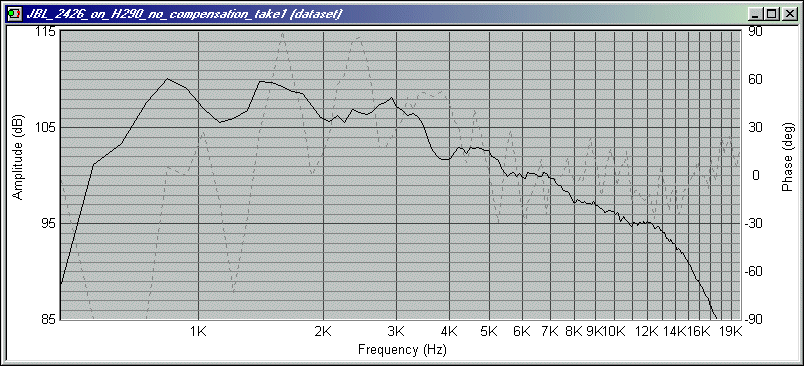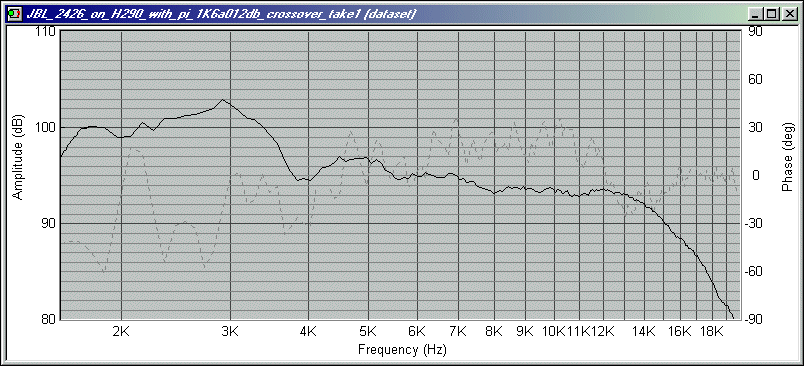| Driver selections [message #66760] |
Fri, 25 March 2011 16:51  |
 JakobR
JakobR
Messages: 8
Registered: March 2011
|
Esquire |
|
|
Hello,
I'm new on this forum. I've been into DIY for some time, using mostly JBL components. I would like to try out the 4pi speakers and have some drivers I would like to use. Preferably JBL 2227 or ME150 and 2451. These drivers differs from the 2226 and for ex. the JBL 2426. Has anyone tried these drivers with the 4pi crossovers? Would it be able to tweak the networks to fit the new drivers without being an engineer? I have measuring capabilities so if I just know witch components to laborate with, I think I'll be fine. Just interested if someone have any input before I go ahead and buy the crossovers.
Thanks,
Jakob
|
|
|
|
|
|
|
|
| Re: Driver selections [message #66766 is a reply to message #66765] |
Sat, 26 March 2011 10:00   |
 |
 Wayne Parham
Wayne Parham
Messages: 18985
Registered: January 2001
|
Illuminati (33rd Degree) |
|
|
The 2426 can be used interchangably with the DE250. It is a smooth high-quality driver that used to be what I put in my fully upgraded top-of-the line systems. The thing is, it rolls off fairly early giving you what most audiophiles would call a "polite" top end. If that's what you like, then go for it. But it just isn't as good as the DE250, in my opinion.
The JBL 2451 is a 1-1/2" compression driver, so can't be used with this design. It has even less top end than the JBL 2426, so even if it could be made to fit, I wouldn't be satisfied with its performance. I personally don't like to go with larger compression driver because the top-octave isn't as good. In most cases it isn't there and even in the better drivers with Beryllium diaphragms (that do have top-octave output), throat dimensions make the top octave beamy, basically set by the internal throat angle (about 10°). Bottom line, only 1" exit drivers can be used in any of my designs.
As for the 2227, it can be used in place of the 2226 but it cannot be made to work as well. It's not terrible, and in fact, has some advantages, specifically, greater max SPL from better thermal control. So if you are looking for high SPL applications, you might consider using it. You'll definitely need subs with that driver, but really, you need subs with the 2226 too.
The problem with the 2227 is in the crossover region. It has a fairly pronounced on-axis rise around 1kHz. It's not bad at all off-axis, and so with the crossed-axes setup it sounds pretty good. The overall power response isn't too bad because up that high, the off-axis response is falling off, matching the horn. But still, it doesn't match as well as the 2226, which is why I no longer offer it for my top-of-the line systems.
|
|
|
|
|
|
| Re: Driver selections [message #66770 is a reply to message #66769] |
Sat, 26 March 2011 18:31   |
 |
 Wayne Parham
Wayne Parham
Messages: 18985
Registered: January 2001
|
Illuminati (33rd Degree) |
|
|
The horn used is the H290. That's what the design is optimized for. Measurements of the speaker are at the following link:
Speakers with JBL 2426 drivers are often advertised to go out to 16kHz - and they do - but it's with gentle rolloff. I've also seen some designs that boost the top-octave with peaking coils to bump up the response at 16kHz. Either way, you're dealing with a pretty good driver, but one that should only be expected to reach 14kHz or maybe 16kHz with an extra peaking circuit.
Here are some measurements (pay attention only to 4kHz upwards because of the conditions of the test):
 JBL 2426 on H290 without top-octave compensation
JBL 2426 on H290 without top-octave compensation
That's actually a very nice curve for a compression driver. The downward trend you see is typical, a textbook-case 6dB/octave slope from mass-rolloff. The thing is, at 12kHz or 13kHz, the next filter function kicks in, that of voice coil inductance. That's the beginning of the end for this driver.
 JBL 2426 on H290 with π top-octave compensation
JBL 2426 on H290 with π top-octave compensation
Here we see the response with the crossover providing 6dB/octave boost to counter for mass-rolloff. That makes it nice and flat up to 12kHz or so, but then it starts rolling off.
You can read more about compression drivers and why they act this way in the whitepaper below. It's written to help the reader understand speakers like these, the crossovers, horns and drivers in them, and why we make the design choices that we do.
When I use the JBL 2426, I use the same basic crossover design I use with all my other speakers. You could use a peaking coil tuned to 14kHz or so to boost another 6dB/octave up there. But even with the added complexity of the extra peaking circuit, you only gain a smidge more high end, like maybe 2kHz. You push the upper -3dB point from 14kHz to maybe 16kHz. It's dropping like a rock up there, and I don't see much benefit in pushing the power to the driver trying to eek out that extra air. It's just not worth it to me.
Don't misjudge the sound quality by what you see in the graphs. The 2426 sounds very good, even with the rolloff at 14kHz. Personally, I prefer the sound of the 2426 with mass-rolloff compensation and without any extra boost. I've tried it both ways, and with the extra boost, I think the driver sounds artificial. It sounds very effortless and smooth with the stock crossover, and has plenty of sparkle.
On the other hand, if you don't already own the driver, I wouldn't spend $300 to get it, I'd go with the DE250 instead. I think it is an even better driver, and doesn't cost as much. That's why I stopped using the 2426 and went with the DE250. It's very smooth, has better extension and costs less.
|
|
|
|
|
|
|
|
|
|
|
|







